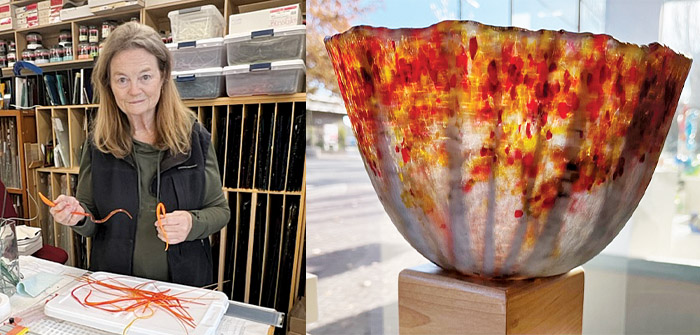((Left) Deb Borine in her home studio (Right) Landscape bowl)
Deb Borine’s fused glass bowls pulsate with rich color and her glass “landscapes” shimmer with painterly trees and sunsets. She has been working with glass for nearly 20 years and still manages to come up with fresh ideas for her creations. Her work is on display at Red Chair Gallery.
Recently, she has been incorporating dichroic glass into her work in new ways. Dichroic glass can display as multiple different colors depending on lighting conditions. In the bowl pictured here, Borine employs it on a transparent blue glass background to create a contrasting opaque design with a slightly glittery look.
Years ago, she started making flat glass panels on which she designed landscapes with tree branches, leaves and sunsets. She cuts the tree shapes out of glass sheets and then applies layers of frit (ground glass ranging from powder to coarse) to make the leaves and sunset streaks before fusing the whole thing. Now she has elevated the landscape concept into making bowls. To start, she cuts a piece of glass into a large circle like a rolled-out piecrust. After applying the flat glass tree trunks and branches, she layers on the frit to complete the design. This flat piece is fired and flipped to the other side, where she applies the design for the other side. Now it looks like a loaded pizza and she fires it again. Then the whole piece is slumped or draped into a bowl mold and fired another three or four times to get a steep sided bowl.
Fusing glass requires a thorough understanding of the temperature ranges required for glass to go from its original cold state to molten and then cooling and annealing the glass back into its cold state once more. Different types of glass have different coefficients of expansion (COE) when heated. The COE is the ratio of the increase in expansion of the glass as it rises in temperature and in the way it shrinks as it cools. Both pieces of glass must cool at the same rate. If you are fusing two types of glass with different COEs, the result will be a weakened piece of glass that is prone to breaking or shattering if it even survives the fusing process, Borine explains.
If you are fusing two different colors together, you must consider the potential chemical reactions of these two glasses when in molten form. Elements and metals like copper, selenium, sulfur, silver, aluminum or gold are used to create the colors of the glass. The artist must know how they might react when fused together, she notes.
So-called “striker” glass will change color radically upon firing so the artist needs to understand this concept, as the result could be a surprise or unanticipated color, she warns. These principles are only a few of the many rules of glass-making that an artist needs to master.
A typical firing takes 12-14 hours and Borine’s computerized kiln carefully regulates the heat to prevent thermal shock as the temperature slowly rises to 1,480 degrees (a full fuse) and then gradually decreases during the annealing process on the way down. The thicker the glass, the longer the firing takes. Her simple, but elegant, olive oil and vinegar garlic plates require three firings: one to create the base, one for the added frit, and the last to slump the piece in a mold. Usually, she can only fire one large piece at a time, unlike ceramic artists who can often fire many pieces at once. It’s a laborious process but it results in brilliant glass creations.
A Bend resident since 1978, Borine always had a creative bent and worked with many art forms, including stained glass, basket weaving, quilting, fiber art, metal art and jewelry. But nothing captivated her more than fused glass. “Once I found kilnformed glass, that was it for me,” she says.
She started taking glass-making classes in 2007 from Kate McLeod, who owned Glass Symphony, an art glass gallery on Wall Street. The landlord asked McLeod to design a stained glass panel to insert above the front door, which she made with Borine’s collaboration. You can still see it at 916 NW Wall Street, although the space is occupied by another business.
Borine also established and managed a glass guild for ten years and taught fused glass classes at Central Oregon Community College for eight years and now offers private lessons at her studio. She has been a member of Red Chair Gallery since it opened 15 years ago. Besides exhibiting her work there, she is also available to make customer pieces.
Contact Deb Borine at her email: blissglass@bendbroadband.com

